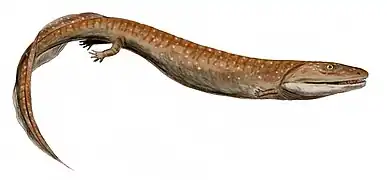| Elpistostegalia | |
|---|---|
 | |
| Panderichthys | |
| Scientific classification | |
| Domain: | Eukaryota |
| Kingdom: | Animalia |
| Phylum: | Chordata |
| Clade: | Sarcopterygii |
| Clade: | Tetrapodomorpha |
| Clade: | Eotetrapodiformes |
| Clade: | Elpistostegalia Camp & Allison, 1961 |
| Type genus | |
| Elpistostege Westoll, 1938 | |
| Subgroups[1] | |
| Synonyms | |
| |
Elpistostegalia or Panderichthyida is an order of prehistoric lobe-finned fishes which lived during the Middle Devonian to Late Devonian period (about 385 to 374 million years ago).[2] They represent the advanced tetrapodomorph stock, the fishes more closely related to tetrapods than the osteolepiform fishes. The earliest elpistostegalians, combining fishlike and tetrapod-like characters, are sometimes called fishapods, a phrase coined for the advanced elpistostegalian Tiktaalik. Through a strict cladistic view, the order includes the terrestrial tetrapods.
Palaeobiology
A rise in global oxygen content allowed for the evolution of large, predatory fish that were able to exploit the shallow tidal areas and swamplands as top predators.[3] Several groups evolved to fill these niches, the most successful were the elpistiostegalians. In such environments, they would have been challenged by periodic oxygen deficiency.[4] In comparable modern aquatic environments like shallow eutrophic lakes and swampland, modern lungfish and some genera of catfish also rely on the more stable, atmospheric source of oxygen.[5][6]
Being shallow-water fishes, the elpistostegalians evolved many of the basic adaptions that later allowed the tetrapods to become terrestrial animals. The most important ones were the shift of main propulsion apparatus from the tail fin to the pectoral and pelvic fins, and a shift to reliance on lungs rather than gills as the main means of obtaining oxygen.[7] Both of these appear to be a direct result of moving to an inland freshwater mode of living.[8]
The elpistostegalians gave rise to the tetrapods in the Eifelian (early middle Devonian) around 395 million years ago. While the early tetrapods flourished and diversified over the next 30 million years, the non-tetrapod elpistostegalians disappear from the fossil record fairly quickly in the early Frasnian around 380 million years ago, leaving the tetrapods the sole survivors of their line.[9]
Traits
Paleontologist and professor Per E. Ahlberg has identified the following traits as synapomorphic for Elpistostegalia (and thus Tetrapoda):[10]
- The endocranium is hinged, the hinge forming the profundus nerve foramen. The cranial kinesis is also visible in the skull roof, between the parietal bones and the postparietal bones.
- A rather small shoulder girdle is present.
- The anal and posterior dorsal fin supported by a basal plate and three unjointed radials.
- The pectoral fin skeleton is composed of bones homologous to the tetrapod humerus, ulna, and radius, followed by a host of smaller bones anchoring the fin rays; the pelvic fin skeleton similarly has femur, tibia, and fibula.
Phylogeny
The name, originally coined around the genus Elpistostege, later become a synonym for Panderichthyida.[7] In most analyses, the group as traditionally imagined is actually an evolutionary grade, the last "fishes" of the tetrapod stem line, though Chang and Yu (1997) treated them as the sister clade to Tetrapoda.[10][11] Elpistostegalia was re-defined as a clade containing Panderichthys and tetrapods.[1]
Below is a cladogram from Swartz, 2012.[1]
| Eotetrapodiformes |
| ||||||||||||||||||||||||||||||||||||||||||||||||||||||||||||||||||||||||||||||||||||
References
- 1 2 3 Swartz, B. (2012). "A marine stem-tetrapod from the Devonian of Western North America". PLOS ONE. 7 (3): e33683. Bibcode:2012PLoSO...733683S. doi:10.1371/journal.pone.0033683. PMC 3308997. PMID 22448265.
- ↑ Elpistostegidae on the Taxonomicon
- ↑ Dahl TW, Hammarlund EU, Anbar AD, et al. (October 2010). "Devonian rise in atmospheric oxygen correlated to the radiations of terrestrial plants and large predatory fish". Proc. Natl. Acad. Sci. U.S.A. 107 (42): 17911–5. Bibcode:2010PNAS..10717911D. doi:10.1073/pnas.1011287107. PMC 2964239. PMID 20884852.
- ↑ Lewis, William M. Jr. (1 June 1970). "Morphological Adaptations of Cyprinodontoids for Inhabiting Oxygen Deficient Waters" (PDF). Copeia. 2 (2): 319–326. doi:10.2307/1441653. JSTOR 1441653. Archived from the original (PDF) on 2011-08-13.
- ↑ Long, J.A. (1990). "Heterochrony and the origin of tetrapods". Lethaia. 23 (2): 157–166. doi:10.1111/j.1502-3931.1990.tb01357.x.
- ↑ Armbruster, Jonathan W. (1998). "Modifications of the Digestive Tract for Holding Air in Loricariid and Scoloplacid Catfishes" (PDF). Copeia. 1998 (3): 663–675. doi:10.2307/1447796. JSTOR 1447796. Retrieved 25 June 2009.
- 1 2 Gordon, M.S.; Long, J.A. (2004). "The Greatest Step In Vertebrate History: A Paleobiological Review of the Fish-Tetrapod Transition" (PDF). Physiological and Biochemical Zoology. 77 (5): 700–719. doi:10.1086/425183. PMID 15547790. S2CID 1260442.
- ↑ Ahlberg, P.E. (1998). "Postcranial stem tetrapod remains from the Devonian of Scat Craig, Morayshire, Scotland". Zoological Journal of the Linnean Society. 122 (1–2): 99–141. doi:10.1111/j.1096-3642.1998.tb02526.x.
- ↑ Niedźwiedzki, Grzegorz; Szrek, Piotr; Narkiewicz, Katarzyna; Narkiewicz, Marek; Ahlberg, Per E. (2010). "Tetrapod trackways from the early Middle Devonian period of Poland". Nature. 463 (7277): 43–8. Bibcode:2010Natur.463...43N. doi:10.1038/nature08623. PMID 20054388. S2CID 4428903.
- 1 2 Ahlberg, P.E; Johanson, Z. (1998). "Osteolepiforms and the ancestry of tetrapods" (PDF). Nature. 395 (6704): 792–4. Bibcode:1998Natur.395..792A. doi:10.1038/27421. S2CID 4430783. Archived from the original (PDF) on 2014-11-24. Retrieved 2011-03-12.
- ↑ Chang, M.-M.; Yu, X. (1997). "Reexamination of the relationship of Middle Devonian osteolepids–fossil characters and their interpretations". American Museum Novitates (3189): 1–20.
.jpg.webp)




